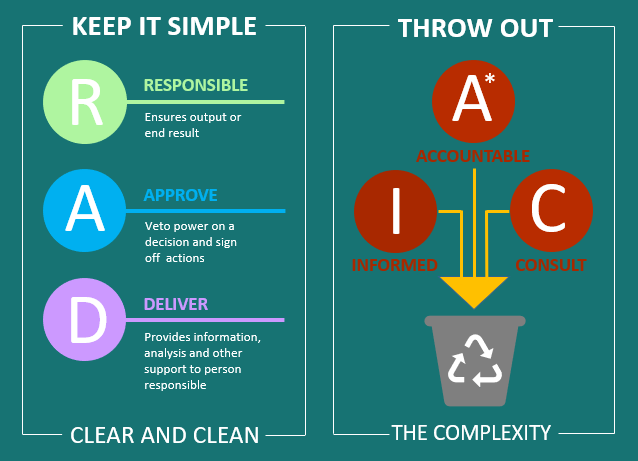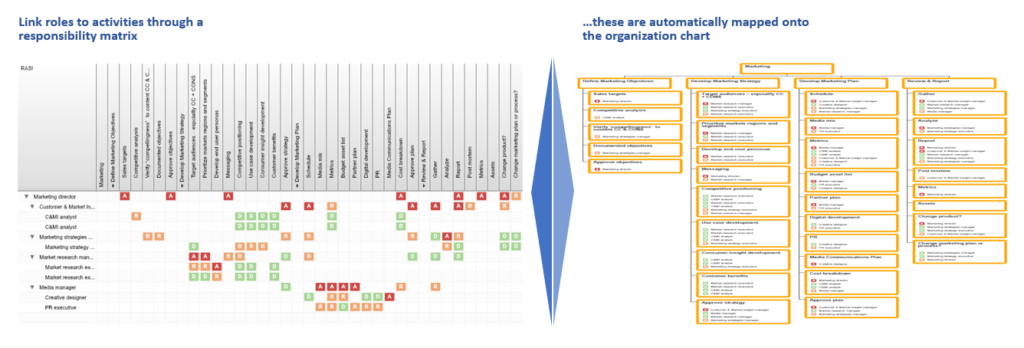RACI vs RASIC or RAPID for Decision-Making: throw out the complexity
This article contests the usefulness of these models
[This article was updated on Sep 20, 2023]
RACI is arguably the most popular tool for responsibility planning. RAPID puts a decision-making spin on this framework. But do you need either? This article contests the usefulness of these models, and explains how to remove the complexity and introduce a more effective approach that centers around approval and delivery.
As organizations grow, understanding what work needs to be done and how to divide that work among the workforce becomes more and more complex. By linking the organizational system to time allocation and accountability, you can begin to see which roles are connected to which activities to understand where the gaps are.
Assigning activities to roles is usually done using an ‘accountability matrix’. Although RACI is the most popular matrix for this task, I would argue that it doesn’t provide enough clarity around roles and responsibilities. Far from simplifying the process, RACI makes it more complex than it needs to be.
What is RACI?
Also known as RACI Matrix, RACI stands for Responsible, Accountable, Consulted, Informed. Each letter in the acronym represents the level of responsibility each person involved in the project has on a decision or task. It helps organizations decide, at a more granular level than simple task assignments, what each person is doing.
Benefits of RACI
- Eliminates confusion and clarifies roles.
- Ensures nothing falls through the cracks and keeps projects in line.
- Ensures smooth turnovers and transitions.
- Prioritizes communication between participants and stakeholders.
- Encompasses all aspects of any size project, improving efficiency.
What is RAPID or RASIC?
RAPID stands for Recommend, Agree, Perform, Input, Decide. Each letter in the acronym represents a person or role in an organization’s decision making process. RAPID is a framework that helps improve and guide an organization’s decision making and can help them become more efficient and productive as a result.
RASIC, on the other hand, stands for Responsible, Approve, Support, Inform, Consult and each letter in the acronym represents a designated role in a task’s completion.
Benefits of RAPID
- All decisions receive careful consideration, allowing different perspectives to spot different opportunities or challenges.
- Allows all individuals on a team to participate in the decision making process.
- Input from all employees assists with the final decision, distributing power in an organization.
- Employees feel empowered, giving them a sense of ownership over the work and the entire organization.
- Increased transparency in the decision making process.
- Decision accountability across teams and individuals.
RACI framework doesn’t give enough clarity on roles and responsibilities
The first time I came across RACI was during an organizational design project for an automotive company in South Africa in the 1990s. As part of the prep, I reviewed our methodology and discovered the accountability framework we would use to determine who’s Accountable (A) for an activity (or decision), who needs to be Consulted (C) or Informed (I), and who is ultimately Responsible (R) for that activity.
But as I contemplated its usefulness, a series of questions came to mind:
- What is the difference between being Accountable and Responsible?
- How important is it to define who needs to be Consulted and Informed?
- What about the people who need to be involved in actually doing the work?
- And what about those who have a veto on a decision, or think they should have?
- The point of the ‘A’ and the ‘R’ is that there should only be one person involved, a single point of accountability. But what happens if there are two (or more) decision makers, i.e. two people that have a veto?
What didn’t occur to me until much later, having used the framework numerous times since, is once you’ve set it up, how do you sustain it? How do you communicate it? How do you make it live? Too often, we define things like RACI as a one-off and people make a big fuss over whether they’re consulted before a decision is made or informed after it’s been made.
Throw out the complexity – make it RAD
We take a different view of RACI and advise clients to simplify the framework by doing the following:

- Remove the ambiguity between ‘R’ and ‘A’ – just have the ‘R’ and define it as Responsible and Accountable
- Simplify the ’I’ and the ’C’ by leaving it to the person responsible to decide who needs to be Informed and Consulted
So, this leaves you with just the ’R’ but we can add more useful elements back in. We can now:
- Define who needs to Approve a decision – ‘A’ helps to clarify governance
- Consider who else is needed to Deliver the work or make a decision
This gives us the ‘RAD’ framework – a simple way of assigning responsibility for activities, identifying who needs to approve the work, and who else needs to be involved to make it happen. No unnecessary meetings, complications, or confusion over accountability.
Orgvue enables you to define the link between roles, processes, and activities through a grid that feels similar to a spreadsheet. But once defined, you can clearly see who is responsible for what within your organization through org chart visualizations. In my view, it’s more important to define what’s in the box rather than where the box sits in the org chart.

Key difference between RACI and RAPID
| Aspect | RACI | RAPID |
| Full Form | Responsible, Accountable, Consulted, Informed | Input, Recommend, Agree, Decide, Perform |
| Purpose | Responsibility planning for activities | Decision-making roles and responsibilities |
| Clarity of Roles | May not provide sufficient clarity | Designed to provide clarity in decision-making |
| Key Roles | Responsible (R), Accountable (A), Consulted (C), Informed (I) | Input (I), Recommend (R), Agree (A), Decide (D), Perform (P) |
| Accountability | May introduce complexity in assigning accountability | Focuses on assigning specific decision roles |
| Decision-Making | Primarily focuses on activities and tasks | Primarily focuses on decision-making processes |
| Ambiguity | Can create ambiguity between ‘R’ and ‘A’ | Designed to avoid ambiguity in decision roles |
| Governance | Doesn’t explicitly address decision approval | Includes ‘Agree’ role for decision approval |
| Execution | Doesn’t explicitly consider roles for execution | Includes ‘Perform’ role for execution |
RAPID vs RACI: which one to choose for decision-making?
Of course, there are frameworks other than RACI for prescribing accountability in an organization. One of the best is RAPID, developed by Bain Consulting.
In Bain’s words: “High-quality decision-making and strong performance go hand in hand. Yet, in many companies, even clear, well-framed decisions can be derailed by uncertainty over roles and responsibilities. To address this common problem, Bain created RAPID®, a loose acronym for Input, Recommend, Agree, Decide. and Perform. RAPID® assigns owners to the five key roles in any decision.”
It’s important to say there‘s no right or wrong framework, but you should avoid complexity. Whichever you choose, Orgvue can help you configure the links between people and work to accommodate your preferred framework.
Getting your accountability matrix right and keeping it simple will pay dividends. By combining this with information on the time people spend on individual activities, you can define the cost of each activity and process. And once you can do this, you’re in a position to identify improvements that would make a significant difference to the productivity (and profitability) of your organization.